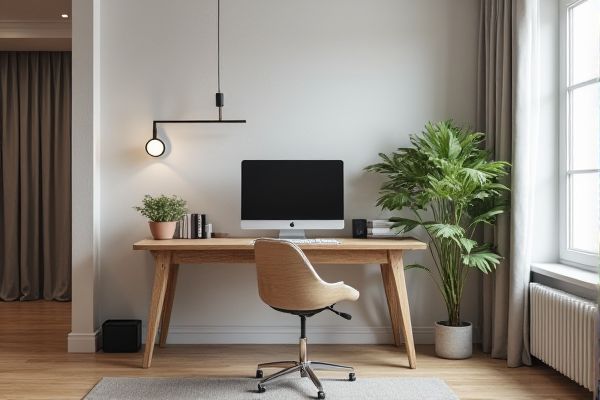
Wall-mounted desks save space and offer a minimalist design ideal for small rooms, while floor-standing desks provide greater stability and flexibility in placement. Explore the detailed comparison to find which desk suits Your workspace needs best.
Table of Comparison
| Feature | Wall-Mounted Desk | Floor-Standing Desk |
|---|---|---|
| Installation | Requires wall mounting; fixed position | Freestanding; easy to move and reposition |
| Space Efficiency | Saves floor space; ideal for small rooms | Consumes floor space; bulkier footprint |
| Stability | Depends on wall strength; very stable once installed | Stable; may wobble on uneven floors |
| Adjustability | Limited to fixed height and position | Often adjustable height; ergonomic options available |
| Weight Capacity | Supports moderate load; depends on wall anchors | Supports heavier equipment and accessories |
| Design & Aesthetics | Minimalist, modern look; seamless integration | Varied styles and materials; traditional to contemporary |
| Price Range | Generally lower cost due to simple design | Wider price range; can be more expensive |
| Mobility | Fixed; not portable | Portable; easy to relocate |
Introduction to Desk Types
Wall-mounted desks save floor space by attaching directly to the wall, offering a minimalist design ideal for small rooms or home offices. Floor-standing desks provide more storage options and stability, making them suitable for heavier equipment and more dynamic work environments. Choosing between the two depends on space availability, ergonomic needs, and the desired aesthetic of the workspace.
Overview of Wall-Mounted Desks
Wall-mounted desks maximize space efficiency by attaching directly to the wall, ideal for small rooms or minimalist setups. These desks offer adjustable heights and folding options, enhancing ergonomics and convenience while reducing clutter. Common materials include wood, metal, or composite, providing durability and a sleek appearance suitable for modern interiors.
Overview of Floor-Standing Desks
Floor-standing desks provide stability and durability with their robust frame designs, making them suitable for heavy equipment and long-term use. They often offer adjustable height features for ergonomic comfort, catering to both sitting and standing positions. These desks typically occupy more floor space but excel in providing versatile work environments for home offices or professional settings.
Space-Saving Benefits
Wall-mounted desks maximize your room's available space by being fixed directly to the wall, eliminating the need for bulky legs or frames, making them ideal for small rooms or apartments. Floor-standing desks typically occupy more floor area and can limit rearranging options, whereas wall-mounted models free up space underneath for storage or additional furniture. Choosing a wall-mounted desk enhances your workspace efficiency and helps maintain a clean, open environment.
Stability and Durability Comparison
Wall-mounted desks offer excellent space-saving benefits but generally provide less stability compared to floor-standing desks due to their reliance on wall anchors, which may loosen over time. Floor-standing desks feature a solid base that can support heavier loads and endure constant use without wobbling, making them more durable for long-term stability. Your choice should consider the importance of a sturdy work surface, especially if you frequently use heavy equipment or require robust support.
Installation and Setup Requirements
Wall-mounted desks require secure anchoring to studs or solid walls, ensuring stability but demanding precise installation and possibly professional assistance. Floor-standing desks offer straightforward setup with no mounting needed, providing immediate usability and easier rearrangement options. Your choice depends on available wall support and willingness to invest time or help during installation.
Ergonomics and Comfort
Wall-mounted desks offer customizable height adjustments that enhance ergonomics by allowing you to alternate between sitting and standing positions comfortably, reducing strain on your back and neck. Floor-standing desks provide stable support and often come with wider surface areas, but fixed heights can limit optimal posture unless paired with adjustable chairs or accessories. Prioritizing your ergonomic needs, wall-mounted desks tend to promote better movement and comfort in dynamic work environments.
Aesthetic and Design Flexibility
Wall-mounted desks offer sleek, minimalist aesthetics that save floor space and create a modern, airy atmosphere ideal for compact rooms or contemporary interiors. Floor-standing desks provide greater design flexibility with diverse styles, sizes, and storage options, allowing you to choose a piece that complements traditional or eclectic decor. Your choice depends on whether you prioritize space efficiency and streamlined design or versatile functionality and presence.
Cost and Maintenance
Wall-mounted desks typically have lower upfront costs due to simpler designs and fewer materials, while floor-standing desks often come with higher prices reflecting sturdier construction and additional features. Maintenance for wall-mounted desks is minimal, mainly involving occasional tightening of brackets, whereas floor-standing desks may require regular cleaning and lubrication of moving parts to ensure durability. Your choice depends on balancing budget constraints with long-term upkeep preferences.
Which Desk is Right for You?
Choosing between a wall-mounted desk and a floor-standing desk depends on your space, functionality, and style preferences. Wall-mounted desks save floor space and offer a sleek, minimalist design ideal for small rooms or multi-use areas, while floor-standing desks provide more stability and storage options suitable for heavier equipment and longer work sessions. Assess your workspace requirements and ergonomic needs to determine which desk complements your productivity and comfort best.
 homyna.com
homyna.com